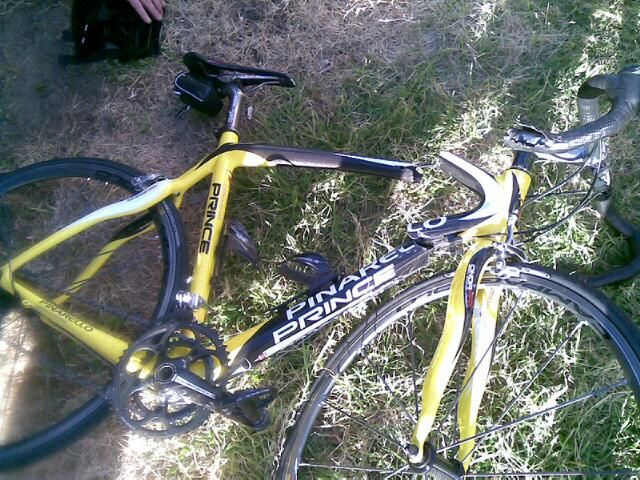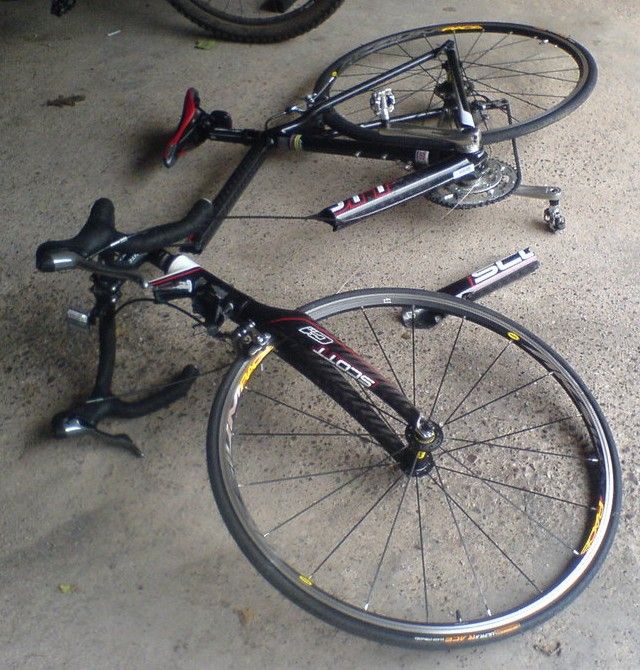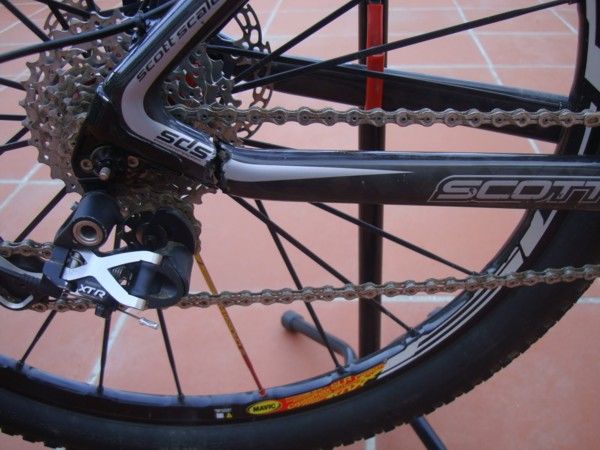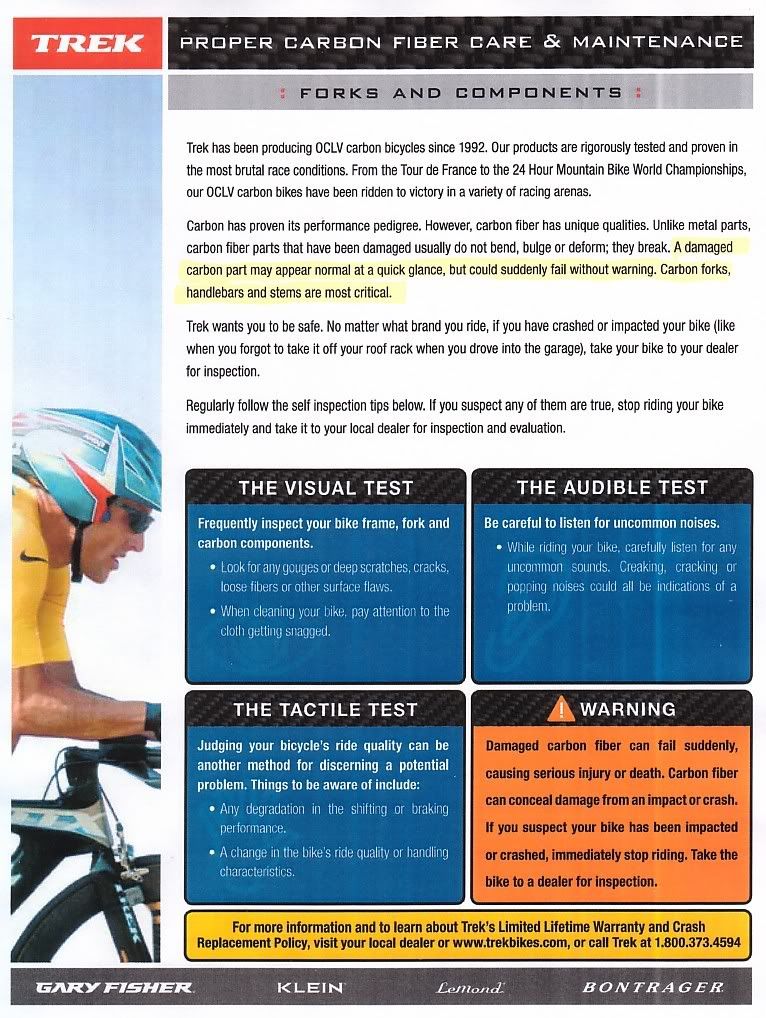Titanium vs. Steel in 2015?
#126
Senior Member
Join Date: Nov 2014
Location: Eugene, Oregon, USA
Posts: 27,547
Mentioned: 217 Post(s)
Tagged: 0 Thread(s)
Quoted: 18374 Post(s)
Liked 4,509 Times
in
3,351 Posts
For me, a significant advantage is the failure mode.
Both titanium and steel have elongation in the 10% - 15% range. They are ductile and will usually fail by bending instead of shattering.
Carbon fiber composites have elongation in the 1% - 4% range, and are quite brittle; when the structure fails it breaks by snapping/shattering instead of bending.
Both titanium and steel have elongation in the 10% - 15% range. They are ductile and will usually fail by bending instead of shattering.
Carbon fiber composites have elongation in the 1% - 4% range, and are quite brittle; when the structure fails it breaks by snapping/shattering instead of bending.
I've seen frames and photos of frames with cracks. I presume they develop slowly over time so rapid failure would be rare as long as a rider pays attention to the bike, but perhaps they could worsen quickly enough that a person might have to walk the second half of a century ride.
CF MTBs are apparently quite resistant to fatigue.
I've seen photos of cracks developing in CF road bikes, although there is some debate on the depth of crack or whether they are primarily in the paint. Material interfaces such as crown/blade attachment points for forks would be a potential place for CF cracks to develop.
#127
Decrepit Member
Ductility is not defined by elongation to either yield or break, but rather by the area under the stress-strain curve to either of those end points, i.e. the energy to yield or break. Do you know how the various materials compare in that regard? And one normally thinks of a stress on a bike tube as an applied force or stress, not an applied deflection or strain. In that sense CF does just fine. And one could also contend that CF's resistance to denting is actually an advantage rather than otherwise.




The warnings about carbon fiber failure mode are prominent in most manufacturers' literature; for example, these are warnings by Trek to buyers of CF bikes:
Originally Posted by Trek "Carbon Fiber Care & Maintenance
...carbon fiber has unique qualities. Unlike metal parts, carbon fiber parts that have been damaged usually do not bend, bulge, or deform; they break. (empasis mine - Stan)
WARNING Damaged carbon fiber can fail suddenly, causing serious injury or death. Carbon fiber can conceal damage from an impact or crash. If you suspect your bike has been impacted or crashed, immediately stop riding. Take the bike to a dealer for inspection.
WARNING Damaged carbon fiber can fail suddenly, causing serious injury or death. Carbon fiber can conceal damage from an impact or crash. If you suspect your bike has been impacted or crashed, immediately stop riding. Take the bike to a dealer for inspection.

#128
Senior Member
Join Date: Nov 2011
Location: Edmonton, AB
Posts: 128
Mentioned: 0 Post(s)
Tagged: 0 Thread(s)
Quoted: 0 Post(s)
Likes: 0
Liked 0 Times
in
0 Posts
If they made CF bikes that looked like a Colnago C40/C50 today without the Colnago name tax, then I would consider it. What I mean, of course, is a nice horizontal top tube without the massive tubes. Mainly, aesthetics. Otherwise, it's older steel or titanium, which can be had for a song used, that satisfy. Threaded bb is nice too! Titanium wins strictly on day to day: no rust, no "Not my colour!", can lean against a lamp pole without scratches, etc. If you are lazy, absentminded, and hard on equipment (like I am), then titanium is truly worthy.
#129
Senior Member
Join Date: Oct 2014
Location: Northern San Diego
Posts: 1,726
Bikes: mid 1980s De Rosa SL, 1985 Tommasini Super Prestige all Campy SR, 1992 Paramount PDG Series 7, 1997 Lemond Zurich, 1998 Trek Y-foil, 2006 Schwinn Super Sport GS, 2006 Specialized Hardrock Sport
Mentioned: 2 Post(s)
Tagged: 0 Thread(s)
Quoted: 59 Post(s)
Likes: 0
Liked 1 Time
in
1 Post
What is true for a fork configuration obviously matters not for frames. And there is nothing wrong with that. An Al frame with a CF fork is a great, synergistic combination. Using the fork thing to bash Al in frames may satisfy you, but it doesn't negate the tremendous utility of Al in modern bicycle frames.
Last edited by D1andonlyDman; 07-09-15 at 06:36 PM.
#130
Decrepit Member
Survivability.
Metallurgy for Cyclists - Carbon Fiber Boasts Tremendous Potential | Scot Nicol
Originally Posted by Scot Nicol, ibis
Now for the bad news: carbon's weak link is elongation. Elongation is your safety net, but with carbon it's low, low, low. Depending on lay-up, it's possible to get some elongation out of carbon. For example, there is a scissoring of layers in the 45-degree plies, but in general we're dealing with a material that doesn't have an overabundance of ductility. Composite designs are not meant to permanently bend. And when they fail, they fail all at once, so designers build in a big safety net.
#131
Senior Member
Join Date: Oct 2014
Location: Northern San Diego
Posts: 1,726
Bikes: mid 1980s De Rosa SL, 1985 Tommasini Super Prestige all Campy SR, 1992 Paramount PDG Series 7, 1997 Lemond Zurich, 1998 Trek Y-foil, 2006 Schwinn Super Sport GS, 2006 Specialized Hardrock Sport
Mentioned: 2 Post(s)
Tagged: 0 Thread(s)
Quoted: 59 Post(s)
Likes: 0
Liked 1 Time
in
1 Post
Yes, the Y-Foil is a road bike that Trek originally developed for Lance to do time trials with in 1998. The fact that it was banned in 1999 by the ICF due to politics to protect small European bicycle manufacturers (At the time, it required a large capital budget to build a CF monocoque frame - whereas nowadays that task can be and usually is contracted out to one of several Chinese factories) does not in any way diminish my enjoyment of the bike as a recreational rider - arguably, it made a used Y-Foil more accessible to someone like me for a good price. Also, even today, 16 years after Trek ceased to make them, Y-Foils are competitively used in triathlons (which are not under the auspices of the ICF). And yes, the shape of the carbon monocoque frame of the Y-foil does a great job of damping out vibration of bumps, without degrading the lateral stiffness and energy transfer to the pedals, as the rear wheel is entirely de-coupled from the rider's seat
#132
Senior Member
Join Date: Nov 2003
Location: SE Minnesota
Posts: 12,275
Bikes: are better than yours.
Mentioned: 1 Post(s)
Tagged: 0 Thread(s)
Quoted: 1 Post(s)
Likes: 0
Liked 3 Times
in
3 Posts
Any crash serious enough to asplode a carbon frame is going to do some serious damage to any frame of any other material, not to mention the rider.
Emphasis added for the significant point.
Now for the bad news: carbon's weak link is elongation. Elongation is your safety net, but with carbon it's low, low, low. Depending on lay-up, it's possible to get some elongation out of carbon. For example, there is a scissoring of layers in the 45-degree plies, but in general we're dealing with a material that doesn't have an overabundance of ductility. Composite designs are not meant to permanently bend. And when they fail, they fail all at once, so designers build in a big safety net.
Metallurgy for Cyclists - Carbon Fiber Boasts Tremendous Potential | Scot Nicol
Metallurgy for Cyclists - Carbon Fiber Boasts Tremendous Potential | Scot Nicol
__________________
Telemachus has, indeed, sneezed.
Telemachus has, indeed, sneezed.
#133
Senior Member
Join Date: Nov 2003
Location: SE Minnesota
Posts: 12,275
Bikes: are better than yours.
Mentioned: 1 Post(s)
Tagged: 0 Thread(s)
Quoted: 1 Post(s)
Likes: 0
Liked 3 Times
in
3 Posts
Not it isn't. It's the fork.
Back in the day, steel was the only material so there wasn't anything else that could be used for a fork. Even then, forks were often a different steel alloy than the frame.
- the part that the front wheels and the stem attach to. The fact that aluminum is not well suited to make forks means that the part of the frame to which the front wheels attach, and which fundamentally impacts the comfort and handling of the bike, will generally be built with something else besides aluminum. It is only a result of the fact that aluminum is not well suited to make forks, that the fork has ever become a discrete component from the main diamond of the frame itself. Back in the day that steel was the dominant frame material, all frames came with forks that were made from the same stuff that the rest of the frame was made with.
__________________
Telemachus has, indeed, sneezed.
Telemachus has, indeed, sneezed.
#134
Senior Member
Join Date: Dec 2009
Location: Houston, TX
Posts: 28,682
Bikes: 1990 Romic Reynolds 531 custom build, Merlin Works CR Ti custom build, super light Workswell 066 custom build
Mentioned: 109 Post(s)
Tagged: 1 Thread(s)
Quoted: 6556 Post(s)
Likes: 0
Liked 58 Times
in
36 Posts
Alias 530 asked an honest question asking about advantages of titanium an steel over carbon fiber in a thread titled "titanium vs. steel", and I offered my opinion based on the physical properties of the materials. Please explain these failures if not because of "applied deflection or strain":




The warnings about carbon fiber failure mode are prominent in most manufacturers' literature; for example, these are warnings by Trek to buyers of CF bikes:





The warnings about carbon fiber failure mode are prominent in most manufacturers' literature; for example, these are warnings by Trek to buyers of CF bikes:

By the way, one other point. The tensile and flexural ductility of materials is determined for standard purposes at very slow speeds such as an increase in deflection of 0.5-2.0 mm/min. Under those conditions yes, you may get up to 15% elongation in steel before catastrophic failure, although the yield point after which the material is essentially ruined will occur much earlier. But a crash occurs at a much, much faster speed so that the resistance to breakage of any frame in a crash is governed by its properties related to resistance to impact. The faster the application of the stress, the shorter will be the elongation to yield and break, temperature being held constant. Just a guess, but I doubt that steel exhibits anything even close to 15% elongation at break in an impact situation.
#135
Senior Member
Join Date: Dec 2009
Location: Houston, TX
Posts: 28,682
Bikes: 1990 Romic Reynolds 531 custom build, Merlin Works CR Ti custom build, super light Workswell 066 custom build
Mentioned: 109 Post(s)
Tagged: 1 Thread(s)
Quoted: 6556 Post(s)
Likes: 0
Liked 58 Times
in
36 Posts
That's a poor semantic argument. The fork is part of the frame - the part that the front wheels and the stem attach to. The fact that aluminum is not well suited to make forks means that the part of the frame to which the front wheels attach, and which fundamentally impacts the comfort and handling of the bike, will generally be built with something else besides aluminum. It is only a result of the fact that aluminum is not well suited to make forks, that the fork has ever become a discrete component from the main diamond of the frame itself. Back in the day that steel was the dominant frame material, all frames came with forks that were made from the same stuff that the rest of the frame was made with.
#136
Senior Member
Join Date: Oct 2014
Location: Northern San Diego
Posts: 1,726
Bikes: mid 1980s De Rosa SL, 1985 Tommasini Super Prestige all Campy SR, 1992 Paramount PDG Series 7, 1997 Lemond Zurich, 1998 Trek Y-foil, 2006 Schwinn Super Sport GS, 2006 Specialized Hardrock Sport
Mentioned: 2 Post(s)
Tagged: 0 Thread(s)
Quoted: 59 Post(s)
Likes: 0
Liked 1 Time
in
1 Post
Nope - the frame is the part of the bike that holds the wheels. The fork is part of the frame, because you can't attach the front wheel without it.
Try using a frame without a fork. You can't.
And aluminum makes a crappy material for that part of the frame.
Claiming that the fork is not part of the frame is like claiming that the hub is not part of the wheel.
Try using a frame without a fork. You can't.
And aluminum makes a crappy material for that part of the frame.
Claiming that the fork is not part of the frame is like claiming that the hub is not part of the wheel.
#137
Decrepit Member
There's always a tradeoff between the added material to build in "a big safety net" and weight savings, but adding material doesn't alter the failure mode.
#138
Decrepit Member
I imagine the reasons for those failures are very similar to the reasons for nearly identical looking failures in steel, aluminum, and titanium.
By the way, one other point. The tensile and flexural ductility of materials is determined for standard purposes at very slow speeds such as an increase in deflection of 0.5-2.0 mm/min. Under those conditions yes, you may get up to 15% elongation in steel before catastrophic failure, although the yield point after which the material is essentially ruined will occur much earlier. But a crash occurs at a much, much faster speed so that the resistance to breakage of any frame in a crash is governed by its properties related to resistance to impact. The faster the application of the stress, the shorter will be the elongation to yield and break, temperature being held constant. Just a guess, but I doubt that steel exhibits anything even close to 15% elongation at break in an impact situation.
By the way, one other point. The tensile and flexural ductility of materials is determined for standard purposes at very slow speeds such as an increase in deflection of 0.5-2.0 mm/min. Under those conditions yes, you may get up to 15% elongation in steel before catastrophic failure, although the yield point after which the material is essentially ruined will occur much earlier. But a crash occurs at a much, much faster speed so that the resistance to breakage of any frame in a crash is governed by its properties related to resistance to impact. The faster the application of the stress, the shorter will be the elongation to yield and break, temperature being held constant. Just a guess, but I doubt that steel exhibits anything even close to 15% elongation at break in an impact situation.
You are welcome to be on the bike with the carbon fork; I'll take the steel one. We'll see which of us escapes with less serious injuries. Caveat emptor.
Last edited by Scooper; 07-09-15 at 11:23 PM.
#139
Senior Member
Join Date: Dec 2009
Location: Houston, TX
Posts: 28,682
Bikes: 1990 Romic Reynolds 531 custom build, Merlin Works CR Ti custom build, super light Workswell 066 custom build
Mentioned: 109 Post(s)
Tagged: 1 Thread(s)
Quoted: 6556 Post(s)
Likes: 0
Liked 58 Times
in
36 Posts
Nope - the frame is the part of the bike that holds the wheels. The fork is part of the frame, because you can't attach the front wheel without it.
Try using a frame without a fork. You can't.
And aluminum makes a crappy material for that part of the frame.
Claiming that the fork is not part of the frame is like claiming that the hub is not part of the wheel.
Try using a frame without a fork. You can't.
And aluminum makes a crappy material for that part of the frame.
Claiming that the fork is not part of the frame is like claiming that the hub is not part of the wheel.
#140
Senior Member
Join Date: Oct 2014
Location: Northern San Diego
Posts: 1,726
Bikes: mid 1980s De Rosa SL, 1985 Tommasini Super Prestige all Campy SR, 1992 Paramount PDG Series 7, 1997 Lemond Zurich, 1998 Trek Y-foil, 2006 Schwinn Super Sport GS, 2006 Specialized Hardrock Sport
Mentioned: 2 Post(s)
Tagged: 0 Thread(s)
Quoted: 59 Post(s)
Likes: 0
Liked 1 Time
in
1 Post
Well then it's evolved to the point that it's become inaccurate. And in any case, Aluminum is not vertically compliant enough to make suitable forks. Which is why it's an inferior frame/fork material, compared to all of the others despite it's light weight and stiffness. And if it makes you more comfortable, I'll simply refer to them as frame/fork material from now on. And BTW, not all frame/forks are double diamond (for example, my Trek Y-Foil), so how does your nomenclature deal with that without being explicitly inaccurate?
Last edited by D1andonlyDman; 07-10-15 at 06:44 AM.
#141
Senior Member
Join Date: Jul 2008
Location: Indianapolis
Posts: 288
Bikes: 2011 Guru Praemio Ti (Rival), 03 Gary Fisher Franken-hardtail
Mentioned: 0 Post(s)
Tagged: 0 Thread(s)
Quoted: 0 Post(s)
Likes: 0
Liked 0 Times
in
0 Posts
Nope - the frame is the part of the bike that holds the wheels. The fork is part of the frame, because you can't attach the front wheel without it.
Try using a frame without a fork. You can't.
And aluminum makes a crappy material for that part of the frame.
Claiming that the fork is not part of the frame is like claiming that the hub is not part of the wheel.
Try using a frame without a fork. You can't.
And aluminum makes a crappy material for that part of the frame.
Claiming that the fork is not part of the frame is like claiming that the hub is not part of the wheel.
#142
Senior Member
Join Date: Oct 2014
Location: Northern San Diego
Posts: 1,726
Bikes: mid 1980s De Rosa SL, 1985 Tommasini Super Prestige all Campy SR, 1992 Paramount PDG Series 7, 1997 Lemond Zurich, 1998 Trek Y-foil, 2006 Schwinn Super Sport GS, 2006 Specialized Hardrock Sport
Mentioned: 2 Post(s)
Tagged: 0 Thread(s)
Quoted: 59 Post(s)
Likes: 0
Liked 1 Time
in
1 Post
#143
Senior Member
Join Date: Nov 2003
Location: SE Minnesota
Posts: 12,275
Bikes: are better than yours.
Mentioned: 1 Post(s)
Tagged: 0 Thread(s)
Quoted: 1 Post(s)
Likes: 0
Liked 3 Times
in
3 Posts
Nope - the frame is the part of the bike that holds the wheels. The fork is part of the frame, because you can't attach the front wheel without it.
Try using a frame without a fork. You can't.
And aluminum makes a crappy material for that part of the frame.
Claiming that the fork is not part of the frame is like claiming that the hub is not part of the wheel.
Try using a frame without a fork. You can't.
And aluminum makes a crappy material for that part of the frame.
Claiming that the fork is not part of the frame is like claiming that the hub is not part of the wheel.
__________________
Telemachus has, indeed, sneezed.
Telemachus has, indeed, sneezed.
#144
Senior Member
Join Date: Dec 2009
Location: Houston, TX
Posts: 28,682
Bikes: 1990 Romic Reynolds 531 custom build, Merlin Works CR Ti custom build, super light Workswell 066 custom build
Mentioned: 109 Post(s)
Tagged: 1 Thread(s)
Quoted: 6556 Post(s)
Likes: 0
Liked 58 Times
in
36 Posts
I don't often give up on somebody ever getting it, but I'm done. Let's see where we are leaving this: because aluminum is not ideal for a fork, then it shouldn't be used for the frame either. Tell that to every major bike manufacturer.
#145
Senior Member
Join Date: Oct 2014
Location: Northern San Diego
Posts: 1,726
Bikes: mid 1980s De Rosa SL, 1985 Tommasini Super Prestige all Campy SR, 1992 Paramount PDG Series 7, 1997 Lemond Zurich, 1998 Trek Y-foil, 2006 Schwinn Super Sport GS, 2006 Specialized Hardrock Sport
Mentioned: 2 Post(s)
Tagged: 0 Thread(s)
Quoted: 59 Post(s)
Likes: 0
Liked 1 Time
in
1 Post
Good. Nobody would benefit from my accepting your inaccurate nomenclature. And I certainly couldn't care less if you give up on my ever acquiescing to your inaccurate nomenclature, even if it's widespread. But just for you, I will be using the term frame/fork from now forward. And even you recognize that aluminum makes a LOUSY material for constructing the frame/fork.
Last edited by D1andonlyDman; 07-10-15 at 07:47 AM.
#146
Senior Member
Join Date: Dec 2009
Location: Houston, TX
Posts: 28,682
Bikes: 1990 Romic Reynolds 531 custom build, Merlin Works CR Ti custom build, super light Workswell 066 custom build
Mentioned: 109 Post(s)
Tagged: 1 Thread(s)
Quoted: 6556 Post(s)
Likes: 0
Liked 58 Times
in
36 Posts
So why is it so successful as a frame material then?
#147
Senior Member
Join Date: Oct 2014
Location: Northern San Diego
Posts: 1,726
Bikes: mid 1980s De Rosa SL, 1985 Tommasini Super Prestige all Campy SR, 1992 Paramount PDG Series 7, 1997 Lemond Zurich, 1998 Trek Y-foil, 2006 Schwinn Super Sport GS, 2006 Specialized Hardrock Sport
Mentioned: 2 Post(s)
Tagged: 0 Thread(s)
Quoted: 59 Post(s)
Likes: 0
Liked 1 Time
in
1 Post
Because it's cheap. But not particularly good, as it makes lousy frame/forks, forcing manufacturers to make their frame/forks with multiple materials. And nowadays, it's only used on the frame/forks of low end bikes.
#148
I'm doing it wrong.
Join Date: Jun 2009
Posts: 4,875
Bikes: Rivendell Appaloosa, Rivendell Frank Jones Sr., Trek Fuel EX9, Kona Jake the Snake CR, Niner Sir9
Mentioned: 85 Post(s)
Tagged: 0 Thread(s)
Quoted: 9742 Post(s)
Liked 2,812 Times
in
1,664 Posts
#149
Senior Member
I'm glad this thread about Titanium vs Steel has now moved onto "CF assplodes" and "Aluminum is crap".
Last edited by dr_lha; 07-10-15 at 07:57 AM.







